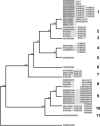Characterization of TEM-1 β-Lactamase-Producing Kingella kingae Clinical Isolates
- PMID: 23796935
- PMCID: PMC3754283
- DOI: 10.1128/AAC.00318-13
Characterization of TEM-1 β-Lactamase-Producing Kingella kingae Clinical Isolates
Abstract
Kingella kingae is a human pathogen that causes pediatric osteoarticular infections and infective endocarditis in children and adults. The bacterium is usually susceptible to β-lactam antibiotics, although β-lactam resistance has been reported in rare isolates. This study was conducted to identify β-lactam-resistant strains and to characterize the resistance mechanism. Screening of a set of 90 K. kingae clinical isolates obtained from different geographic locations revealed high-level resistance to penicillins among 25% of the strains isolated from Minnesota and Iceland. These strains produced TEM-1 β-lactamase and were shown to contain additional ≥50-kb plasmids. Ion Torrent sequencing of extrachromosomal DNA from a β-lactamase-producing strain confirmed the plasmid location of the blaTEM gene. An identical plasmid pattern was demonstrated by multiplex PCR in all β-lactamase producers. The porin gene's fragments were analyzed to investigate the relatedness of bacterial strains. Phylogenetic analysis revealed 27 single-nucleotide polymorphisms (SNPs) in the por gene fragment, resulting in two major clusters with 11 allele types forming bacterial-strain subclusters. β-Lactamase producers were grouped together based on por genotyping. Our results suggest that the β-lactamase-producing strains likely originate from a single plasmid-bearing K. kingae isolate that traveled from Europe to the United States, or vice versa. This study highlights the prevalence of penicillin resistance among K. kingae strains in some regions and emphasizes the importance of surveillance for antibiotic resistance of the pathogen.
Copyright © 2013, American Society for Microbiology. All Rights Reserved.
Figures


References
-
- Chometon S, Benito Y, Chaker M, Boisset S, Ploton C, Berard J, Vandenesch F, Freydiere AM. 2007. Specific real-time polymerase chain reaction places Kingella kingae as the most common cause of osteoarticular infections in young children. Pediatr. Infect. Dis. J. 26:377–381 - PubMed
-
- Ilharreborde B, Bidet P, Lorrot M, Even J, Mariani-Kurkdjian P, Liguori S, Vitoux C, Lefevre Y, Doit C, Fitoussi F, Pennecot G, Bingen E, Mazda K, Bonacorsi S. 2009. New real-time PCR-based method for Kingella kingae DNA detection: application to samples collected from 89 children with acute arthritis. J. Clin. Microbiol. 47:1837–1841 - PMC - PubMed
-
- Korach A, Olshtain-Pops K, Schwartz D, Moses A. 2009. Kingella kingae prosthetic valve endocarditis complicated by a paravalvular abscess. Isr. Med. Assoc. J. 11:251–253 - PubMed
-
- Moumile K, Merckx J, Glorion C, Berche P, Ferroni A. 2003. Osteoarticular infections caused by Kingella kingae in children: contribution of polymerase chain reaction to the microbiologic diagnosis. Pediatr. Infect. Dis. J. 22:837–839 - PubMed
Grants and funding
LinkOut - more resources
Full Text Sources
Other Literature Sources
Molecular Biology Databases
Miscellaneous

